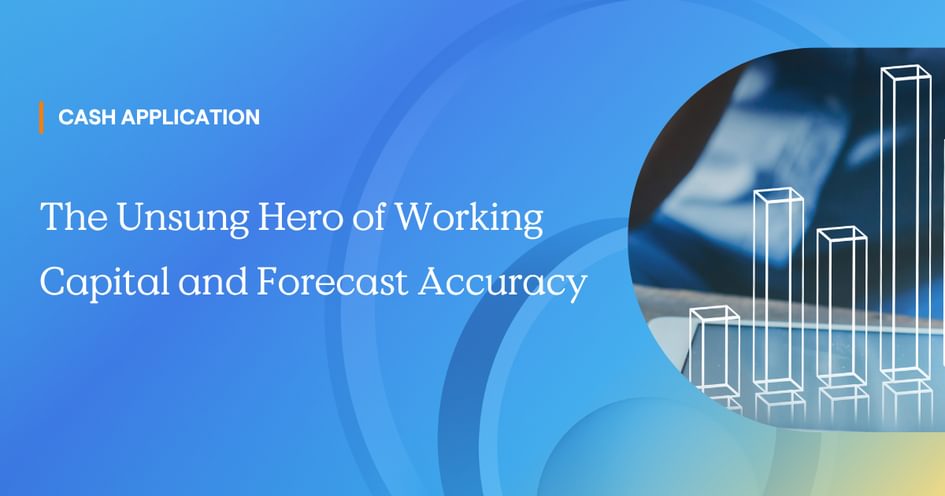Cash Application: The Unsung Hero of Working Capital and Forecast Accuracy

Finance leaders obsess over working capital optimization—extending payables, accelerating collections, tightening cash flow—yet routinely overlook one of their most powerful levers: cash application.
Long treated as a routine operational task, cash application remains stuck in outdated systems and disconnected workflows. This back-office function is silently sabotaging working capital performance at companies across every industry, delaying visibility, distorting metrics, and slowing momentum across the finance function.
The Working Capital Illusion
Here's an uncomfortable truth: your working capital metrics are likely built on quicksand. When payments sit unapplied, they create a dangerous illusion—cash appears on your balance sheet but isn't truly working for your business. It's financial limbo that distorts every working capital calculation downstream.
For mid-market and enterprise organizations processing thousands of payments monthly, these application delays routinely lock up millions in potential working capital. That's capital that should be reducing debt, funding growth initiatives, or improving your competitive position and not sitting in reconciliation purgatory.
The most frustrating part? This trapped capital shows up as "collected" in basic reports, creating a false sense of working capital health while the reality is far less optimistic.
Forecast Accuracy: Garbage In, Garbage Out
When cash application falters, it creates a cascade of uncertainty that undermines even the most sophisticated forecasting models.
The problem compounds quickly: unapplied cash creates unclear AR aging, which leads to imprecise collection forecasts, which forces treasury to maintain excessive cash buffers. These buffers, often millions of dollars sitting idle "just in case", represent a direct cost to your business in terms of opportunity loss or borrowing expense.
CFOs demanding better forecast accuracy are often attacking the wrong problem. No forecasting methodology, no matter how advanced, can overcome the fundamental data problems created by poor cash application. Fix the foundation first.
The Exception Drain: Your Hidden Productivity Crisis
For collections teams, cash application exceptions create an operational black hole. These AR professionals routinely spend 30-40% of their time investigating unapplied payments, reconciling discrepancies, and resolving customer disputes that stem from application errors.
This creates a devastating double-hit to working capital: not only are collectible invoices sitting in limbo, but your collections team is diverted from proactive outreach to reactive problem-solving. Every hour spent reconciling a payment is an hour not spent securing the next one.
The math is brutal. A typical enterprise collections team might handle $300-500 million in annual receivables. If poor cash application diverts even 20% of their capacity, you're effectively leaving millions in accelerated collections on the table each year.
Operational Confidence: The Hidden Benefit
When cash application works efficiently, it creates an operational confidence that permeates the entire finance organization:
- Collections teams work only on genuine past-due accounts, not application errors
- Treasury makes decisions with real-time cash position clarity
- Finance leaders trust the working capital metrics driving their strategy
- Customer relationships improve through billing accuracy
This confidence translates directly to working capital optimization. Teams can reduce safety stock cash balances, make more aggressive deployment decisions, identify true working capital bottlenecks, and provide leadership with reliable forecasts.
The result? A finance organization that's proactive rather than reactive, strategic rather than tactical, and focused on optimization rather than reconciliation.
The Path Forward
The solution isn't an incremental improvement to manual processes. It requires a fundamental rethinking of cash application, one that leverages modern technology to transform this working capital liability into a strategic advantage.
Finance leaders who've tackled this challenge successfully share a common approach:
- They recognize cash application as a strategic priority, not a back-office function
- They implement technology that automates the matching process, even for complex scenarios
- They redirect their teams from manual processing to exception management and analysis
- They integrate cash application data directly into forecasting and working capital decisions
The technology exists today to automate 85-90% of cash application transactions, even in complex B2B environments with multiple remittance formats, various data sources, and payment channels.
Tesorio's Cash Application Agent exemplifies this approach, pulling from diverse data sources—bank files, remittance emails, attachments, and lockbox PDFs—to create a unified view of payment information. By increasing match rates and reducing manual effort, it transforms cash application from a working capital liability to a strategic advantage.
You’ve already earned the revenue. If you’re still relying on manual processes to unlock it, you’re choosing delay over impact, and that decision is costing you.
Discover how Tesorio’s Cash Application Agent takes on the heavy lifting, so your team can focus on accelerating cash flow, not untangling remittance files. Talk with us today.